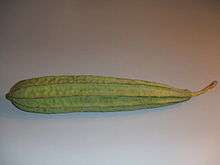Luffa acutangula
Luffa acutangula is commercially grown for its unripe fruits as a vegetable. Mature fruits are used as natural cleaning sponges. Its fruit slightly resembles a cucumber or zucchini with ridges. It ranges from central and eastern Asia to southeastern Asia. It is also grown as a houseplant in places with colder climates. English common names include angled luffa, Chinese okra, dish cloth gourd, ridged gourd, sponge gourd, vegetable gourd, strainer vine, ribbed loofah, silky gourd, ridged gourd, silk gourd,[2][3][4] and sinkwa towelsponge.[5]
| Luffa acutangula | |
|---|---|
 | |
| Scientific classification | |
| Kingdom: | Plantae |
| Clade: | Tracheophytes |
| Clade: | Angiosperms |
| Clade: | Eudicots |
| Clade: | Rosids |
| Order: | Cucurbitales |
| Family: | Cucurbitaceae |
| Genus: | Luffa |
| Species: | L. acutangula |
| Binomial name | |
| Luffa acutangula | |
| Synonyms[1] | |
| |
Uses
The young fruit of some Luffa cultivars are used as cooked vegetables or pickled or eaten raw, and the shoots and flowers are sometimes also used.[6] Like Luffa aegyptiaca, the mature fruits are harvested when dry and processed to remove all but the fruit fibre, which can then be used as a sponge or as fibre for making hats.[6]
Gallery
See also
References
- "The Plant List: A Working List of All Plant Species". Retrieved 21 November 2014.
- M.M.P.N.D. - Sorting Luffa names. Plantnames.unimelb.edu.au (2000-02-06). Retrieved on 2014-05-26.
- Luffa Angled. Kitazawaseed.com (2014-01-22). Retrieved on 2014-05-26.
- Ridged Skin Luffa. Evergreenseeds.com. Retrieved on 2014-05-26.
- "Luffa acutangula". Natural Resources Conservation Service PLANTS Database. USDA. Retrieved 23 June 2015.
- Grubben, G.J.H.; Africa, P.R.o.T. (2004). Vegetables. Backhuys. ISBN 9789057821479.
- Chakravarty, H. L. (October 1948). "Extrafloral Glands of Cucurbitaceæ". Nature. 162 (4119): 576–577. doi:10.1038/162576b0.
| Wikimedia Commons has media related to Luffa acutangula. |
